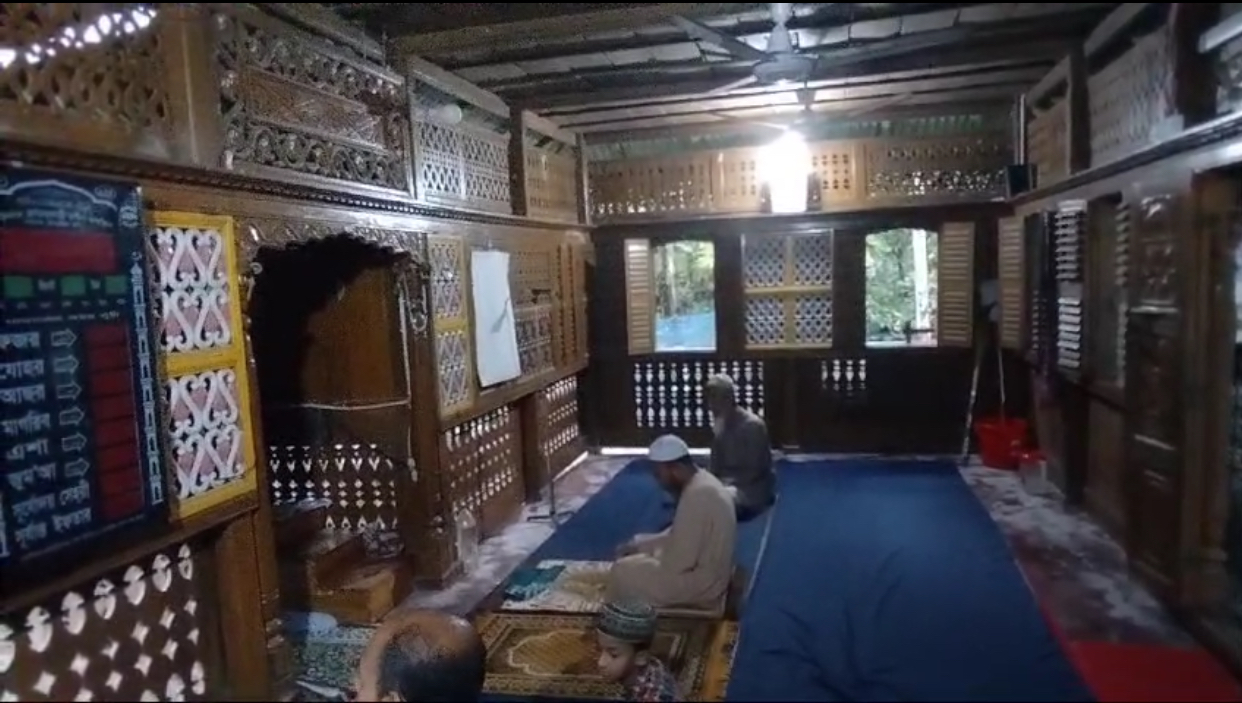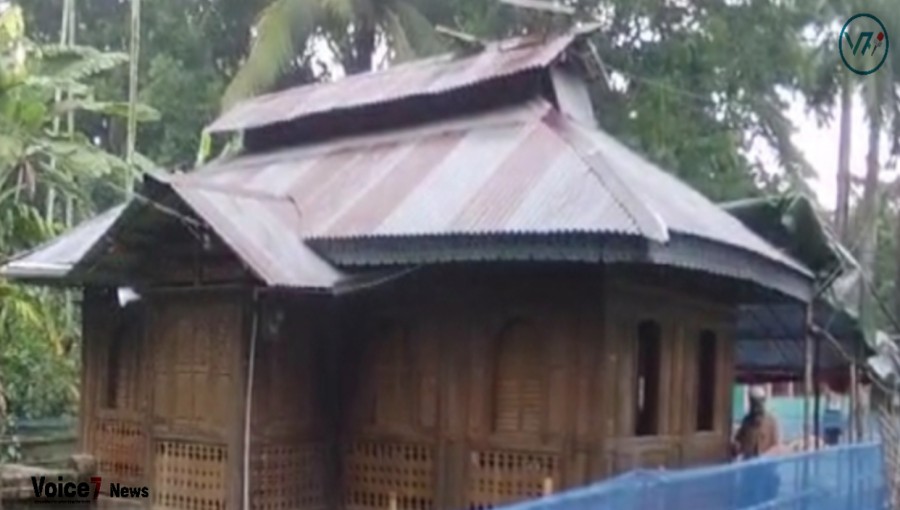It is the demand of the time to develop Momin Masjid as a beautiful tourist spot. Government initiatives are essential for the maintenance and renovation of wooden mosques from the point of view of beauty in woodwork.
One of the masterpieces of Muslim architecture located on the grounds of Akan Bari by the Baleshwar River in Dhanisafa Union No. 2 in Mathbaria, Pirojpur, is Momin Masjid, also known as Momin's Wood Mosque. The sole wooden Muslim building, a traditional Akan home dating back 200 years, and a traditional Momin mosque from South Asia that is around 110 years old.
In the UNESCO portrait study, it is placed 23rd out of the world's most beautiful mosques. This mosque, which is made completely of wooden crafts, is a work of art and a unique architectural and creative creation in Bangladesh. It was made by fusing the architect's own original perfection in European and Indo-Persian styles. The Momin Masjid has a tin roof, is 24 feet long by 18 feet broad.
There are 12 windows in the mosque: 8 east-west and 4 north-south. The calligraphy on the finely carved arches and door is the most fascinating feature. On the upper left side of the entryway, the names of the four caliphs of Islam are adorned in Arabic characters, with the name of Hazrat Muhammad (pbuh) in the centre.
The Bengali year of founding is on the right. To improve the appearance, Burmese teak wood, ebony, and rare ironwood have all been painted in natural hues. The mosque's timber walls are exquisitely adorned with calligraphy, floral patterns, and Islamic culture. The architecture of the mosque is a fusion of European and Indo-Persian styles. The calligraphy on the carved doors and arches is the most fascinating feature.
The mosque's absence of iron stars throughout construction is one of its features. The only Muslim building in Bangladesh with wood carvings is Momin Masjid, designed by Moinuddin Akon.
Upon closer examination, the facts revealed that the mosque is dilapidated, with shrubs and trash everywhere. The walls have various areas of deterioration. The structure is ready to fall into the water. Chowkath is unable to remove both clappers.
A roof is required a few feet above the mosque in order to protect it. This mosque will be shielded from the sun and rain if it is located beneath the shed. It must be raised a few feet because the location is somewhat low lying.
The constant leakage from tin screws prevents worshippers from praying effectively during heavy downpours. The people who live there, including the family of the mosque's founder, harbour resentment.
Library, mini-museum, and park beautification projects are important for visitors. Many visitors come from far and wide to visit this mosque because of its interesting geometric designs and Arabic calligraphy.
There is no accommodation for domestic and foreign tourists. A bungalow and a library should be set up here for the accommodation of tourists. There is no museum or library to learn the history of the establishment of the mosque.
It is the demand of the time to develop Momin Masjid as a beautiful tourist spot. Government initiatives are essential for the maintenance and renovation of wooden mosques from the point of view of beauty in woodwork.
Mominuddin Akon's Douhitra, Dr. Md. Shahidullah Akon, a researcher at Thomas Jefferson Medical University in America, wrote a book titled "Momin Masjid: Smriti Bismriti Katha" about the archaeological importance of Momin Masjid and the need for maintenance.
As a result, in 2003, the mosque was declared a protected antiquities, and the Ministry of Cultural Affairs listed it as a "preserved antiquities" in a notification dated April 17, 2003, for its preservation.
The mosque had minor renovations in 2008 and 2021, however it was not secured. Md. Abul Kalam Azad, Mominuddin's douhitra master, is in charge of maintaining the mosque.
In honour of Momin Masjid, Udayatara Burirchar village's Bhagnadasha Road bears its name. It is known that Momin Uddin Akan, a local social worker, took the personal effort to build Momin Mosque in 1913. Even though it was initially constructed on just 3.5 percent of the property, a total of 14 percent of the land was eventually granted. The mosque was founded by the devout Momin Uddin Akan.
As time goes on and the artistry becomes more appealing, Momin Masjid becomes a household name. The mosque was constructed over seven years, from 1913 to 1920, by 22 carpenters. To complete the structure, priceless shawls, ironwood, and Burmese teak were brought in from Assam, Tripura, and Myanmar. The district's expert carpenters from Nesharbad upazila built the mosque entirely without the use of iron.
The son-in-law of Momin Uddin According to Md. Abul Kalam Azad Akon, Mr. Harkumar Mistry of Swarupkathi in the district served as the primary mason throughout the mosque's construction. Mominuddin Akon, who passed away on October 7, 1958, was born on 1883, into a distinguished Muslim family in Mathbaria, Pirojpur district's Udaitara Burirchar hamlet. At the age of six, Ibrahim Akon, his father, passed away.
Mominuddin Akan received instruction in Arabic and Persian as a youngster from a Maulana from Noakhali, who was a native of Calcutta Aliya Madrasah. In other words, he was already religiously conscious.
Maulvi Ibrahim Akon, the son of peasant leader of the anti-British movement Idris (Idir) Howlader, was the father of Mominuddin Akon. According to history, Mominuddin's father, Maulvi Ibrahim Akon, was the son of Mohsenuddin, also known as Dudu Mia's, the local khalifa of the Faraji movement, and Haji Shariatullah, the head of the anti-British campaign.
Md. Momin Uddin Akon, the head of the Faraji movement, was a disciple of Gaddinshin Pir Badshah Miya , the son of Pir Mohsin Uddin Dudu Mia, the patron of the Farayezi movement, and the son of Shariatullah. Idir (Idris) Howlader, Momin Uddin's grandfather, and his two brothers, Khidir and Yousub (Isab) Howlader, were leaders and fighters among the peasant community who opposed the British.
As Bolaki Shah's fellow fighter, Sufi Fakir's farmer leader, a farmer from Sugandia village in southern Bakherganj, and the leader and warrior of the anti-British peasant movement in the southern area, they carried out the anti-British struggle.
The first person in South Bengal to declare a firm declaration of independence after being emancipated from British domination was Bolaki Shah. In 1792 AD, Bolaki Shah declared his independence from the British. They escaped to Udaitara Burirchar village of Mathbaria Upazila of Pirojpur in 1792 after being routed by the British during the conflict in Sugandia village of Navgram Union of Jhalkathi Sadar Upazila.
In addition, Burirchar led the three brothers in the peasant uprisings in Tuskhali in Mathbaria, Pirojpur district, from 1830 to 1871, and Shingkhali in Bhandaria, the same district, in 1858. Momin Uddin's grandfather Idris (Idir), the rebel peasant leader of the anti-British movement, and Idir's two brothers, Khidir and Yusuf (Isab), along with father Ibrahim Hawladar, organised 23 surrounding villages, including Tuskkhali, according to the seventh grade history and social science exercise book published by NCTB in 2023.
An introduction has been made detailing the peasant revolt's leadership history. Momin Masjid is situated on the Baleshwar Bank in Mathbaria Upazila, Pirojpur District, in the Akon Bari Premises of Udaitara Burirchar Village of No. 02 Dhanisafa Union. In front of the mosque lies a field. The residents of the area took the initiative to create a primary school there. All around the mosque are the intact tombs of four individuals who belonged to Momin Uddin Akan.
You must travel by launch or bus from any location to Tusakhali harbour in Mathbaria, Pirojpur district. You must go down Momin Masjid Road to get to Momin Masjid from the Tushkhali bus terminal. Momin Uddin's brother-in-law Abul Kalam Azad stated that time is of the essence when it comes to preserving Momin Masjid, a symbol of Muslim architecture.
Voice7 News spoke with Abdul Qayyum, the Upazila Nirbahi Officer, on the mosque's repairs. He stated that while some work has already been completed, the remaining work would be completed by contacting the appropriate authorities.
END/V7N/RZP/DK/



Comment: